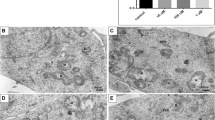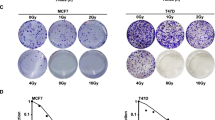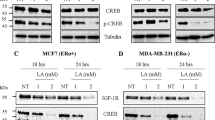Abstract
The Ewing sarcoma is the second most common bone tumor in children and young adults. Despite the advances in therapy, the 5-year survival rate for patients with metastatic disease is poor, indicating the need for alternative treatments. Here, we report that 2-methoxy-estradiol (2-Me), a natural estrogen metabolite, induced a caspase-dependent apoptosis of Ewing sarcoma-derived cells independently of their p53 status. 2-Me-induced apoptosis occurred through the mitochondrial death pathway as evidenced by reduction of the mitochondrial transmembrane potential, cytochrome c release and caspase-9 activation. Treatment of cells with 2-Me resulted in generation of intracellular H2O2, which occurred earlier than caspase-9 activation. The H2O2-reducing agent Ebselen and the lipid peroxidation inhibitor vitamin E decreased both 2-Me-induced caspase-9 activation and cell death, thus providing evidence for a role of H2O2 and lipid peroxides in the initiation of this process. Rotenone, an inhibitor of the mitochondrial respiratory chain, abolished both apoptosis and H2O2 production, thereby identifying mitochondria as the source of H2O2. Moreover, we observed that treatment of cells with 2-Me or H2O2 induced activation of the c-Jun N-terminal kinase (JNK). Overexpression of a dominant-negative mutant of JNK1 reduced 2-Me-induced apoptosis indicating that JNK participates in this process. Altogether, our results provide evidence that 2-Me triggers apoptosis of Ewing sarcoma cells through induction of a mitochondria redox-dependent mechanism and suggest that this compound or other agents that selectively increase the level of reactive oxygen species may prove useful to the development of novel strategies for treatment of Ewing tumors.
This is a preview of subscription content, access via your institution
Access options
Subscribe to this journal
Receive 50 print issues and online access
$259.00 per year
only $5.18 per issue
Buy this article
- Purchase on Springer Link
- Instant access to full article PDF
Prices may be subject to local taxes which are calculated during checkout










Similar content being viewed by others
References
Adler V, Yin Z, Tew KD and Ronai Z . (1999). Oncogene, 18, 6104–6111.
Aoki H, Kang PM, Hampe J, Yoshimura K, Noma T, Matsuzaki M and Izumo S . (2002). J. Biol. Chem., 277, 10244–10250.
Ashkenazi A and Dixit VM . (1998). Science, 281, 1305–1308.
Atfi A, Buisine M, Mazars A and Gespach C . (1997). J. Biol. Chem., 272, 24731–24734.
Attalla H, Westberg JA, Andersson LC, Adlercreutz H and Makela TP . (1998). Biochem. Biophys. Res. Commun., 247, 616–619.
Benhar M, Engelberg D and Levitzki A . (2001). EMBO Rep., 3, 420–425.
Cai J and Jones DP . (1999). J. Bioenerg. Biomembr., 31, 327–334.
Castedo M, Ferri K, Roumier T, Metivier D, Zamzami N and Kroemer G . (2002). J. Immunol. Methods, 265, 39–47.
Curtin JF, Donovan M and Cotter TG . (2002). J. Immunol. Methods, 265, 49–72.
Dauphinot L, De Oliveira C, Melot T, Sevenet N, Thomas V, Weissman BE and Delattre O . (2001). Oncogene, 20, 3258–3265.
Delattre O, Zucman J, Plougastel B, Desmaze C, Melot T, Peter M, Kovar H, Joubert I, de Jong P, Rouleau G et al. (1992). Nature, 359, 162–165.
Deng X, Xiao L, Lang W, Gao F, Ruvolo P and May Jr WS . (2001). J. Biol. Chem., 276, 23681–23688.
DeSilva DR, Jones EA, Favata MF, Jaffee BD., Magolda RL, Trzaskos JM and Scherle PA . (1998). J. Immunol., 160, 4175–4181.
Djavaheri-Mergny M, Marsac C, Maziere C, Santus R, Michel L, Dubertret L and Maziere JC . (2001). Free Radic. Res., 34, 583–594.
Ekert PG, Silke J, Hawkins CJ, Verhagen AM and Vaux DL . (2001). J. Cell Biol., 152, 483–490.
Ferri KF and Kroemer G . (2000). BioEssays, 23, 111–115.
Fleury C, Mignotte B and Vayssiere JL . (2002). Biochimie, 84, 131–141.
Fotsis T, Zhang Y, Pepper MS, Adlercreutz H, Montesano R, Nawroth PP and Schweigerer L . (1994). Nature, 368, 237–239.
Gupta S . (2000). Life Sci., 69, 2957–2964.
Halliwell B and Gutteridge JM . (1984). Lancet, 2, 1095.
Hamel E, Lin CM, Flynn E and D'Amato RJ . (1996). Biochemistry, 35, 1304–1310.
Hashimoto M, Hsu LJ, Rockenstein E, Takenouchi T, Mallory M and Masliah E . (2002). J. Biol. Chem., 277, 11465–11472.
Huang P, Feng L, Oldham EA, Keating MJ and Plunkett W . (2000). Nature, 407, 390–395.
Javelaud D and Besancon F . (2001). Oncogene, 20, 4365–4372.
Kotamraju S, Konorev EA, Joseph J and Kalyanaraman B . (2002). J. Biol. Chem., 275, 33585–33592.
Kovar H . (1998). Curr. Opin. Oncol., 10, 334–342.
Kovar H, Auinger A, Jug G, Aryee D, Zoubek A, Salzer-Kuntschik M and Gadner H . (1993). Oncogene, 8, 2683–2690.
Kumar AP, Garcia GE and Slaga TJ . (2001). Mol. Carcinogen., 31, 111–124.
Kushner BH and Meyers PA . (2001). J. Clin. Oncol., 19, 870–880.
Ledenev AN, Konstantinov AA, Popova E and Ruuge EK . (1986). Biochem. Int., 13, 391–396.
Lin HL, Liu TY, Chau GY, Lui WY and Chi CW . (2000). Cancer, 89, 983–994.
Mukhopadhyay T and Roth JA . (1997). Oncogene, 14, 379–384.
Nakamura Y, Kawakami M, Yoshihiro A, Miyoshi N, Ohigashi H, Kawai K, Osawa T and Uchida K . (2002). J. Biol. Chem., 277, 2687–2694.
Nomura K, Imai H, Koumura T and Nakagawa Y . (2001). Biol. Signals Recept., 10, 81–92.
Oberlin O, Deley MC, Bui BN, Gentet JC, Philip T, Terrier P, Carrie C, Mechinaud F, Schmitt C, Babin-Boillettot A and Michon J . (2001). Br. J. Cancer, 85, 1646–1654.
Ollinger K and Kagedal K . (2002). Subcell. Biochem., 36, 151–170.
Petrosillo G, Ruggiero FM, Pistolese M and Paradies G . (2001). FEBS Lett., 509, 435–438.
Pinkerton CR, Bataillard A, Guillo S, Oberlin O, Fervers B and Philip T . (2001). Eur. J. Cancer, 37, 1338–1344.
Pribluda VS, Gubish Jr ER, Lavallee TM, Treston A, Swartz GM and Green SJ . (2000). Cancer Metasta. Rev., 19, 173–179.
Qadan LR, Perez-Stable CM, Anderson C, D'Ippolito G, Herron A, Howard GA and Roos BA . (2001). Biochem. Biophys. Res. Commun., 285, 1259–1266.
Qanungo S, Basu A, Das M and Haldar S . (2002). Oncogene, 21, 4149–4157.
Ramachandran A, Moellering D, Go YM, Shiva S, Levonen AL, Jo H, Patel RP, Parthasarathy S and Darley-Usmar VM . (2002). Biol. Chem., 383, 693–701.
Reed JC . (2000). Am. J. Pathol., 157, 1415–1430.
Reed JC and Green DR . (2002). Mol. Cell, 9, 1–3.
Sartorius U, Schmitz I and Krammer PH . (2001). Chembiochem, 2, 20–29.
Schumacher G and Neuhaus P . (2001). J. Cancer Res. Clin. Oncol., 127, 405–410.
Sies H . (1994). Methods Enzymol., 234, 476–482.
Simon HU, Haj-Yehia A and Levi-Schaffer F . (2000). Apoptosis, 5, 415–418.
Sitailo LA, Tibudan SS and Denning MF . (2002). J. Biol. Chem., 277, 19346–19352.
Sorensen PH, Lessnick SL, Lopez-Terrada D, Liu XF, Triche TJ and Denny CT . (1994). Nat. Genet., 6, 146–151.
Szibor M, Richter C and Ghafourifar P . (2001). Antioxid. Redox Signal, 3, 515–523.
Tang DG, La E, Kern J and Kehrer JP . (2002). Biol. Chem., 383, 425–442.
Yagi K . (1987). Chem. Phys. Lipids, 45, 337–351.
Yue TL, Wang X, Louden CS, Gupta S, Pillarisetti K, Gu JL, Hart TK, Lysko PG and Feuerstein GZ . (1997). Mol. Pharmacol., 51, 951–962.
Zhao R, Masayasu H and Holmgren A . (2002). Proc. Natl. Acad. Sci. USA, 99, 8579–8584.
Zhao Y, Kiningham KK, Lin SM and St Clair DK . (2001). Antioxid. Redox Signal, 3, 375–386.
Acknowledgements
We thank Dr O Delattre and Pr G Lenoir for providing us with the Ewing sarcoma cell lines and Dr A Atfi for the mutant JNK1 plasmid. We are grateful to C Silvestri for professional technical assistance and D Rouillard for FACS analysis. This work was supported by grants from the Institut National de la Santé et de la Recherche Médicale and by a grant of the Association pour la Recherche sur le Cancer (ARC).
Author information
Authors and Affiliations
Corresponding author
Rights and permissions
About this article
Cite this article
Djavaheri-Mergny, M., Wietzerbin, J. & Besançon, F. 2-Methoxyestradiol induces apoptosis in Ewing sarcoma cells through mitochondrial hydrogen peroxide production. Oncogene 22, 2558–2567 (2003). https://doi.org/10.1038/sj.onc.1206356
Received:
Revised:
Accepted:
Published:
Issue Date:
DOI: https://doi.org/10.1038/sj.onc.1206356
Keywords
This article is cited by
-
2-Methoxyestradiol and Hydrogen Peroxide as Promising Biomarkers in Parkinson’s Disease
Molecular Neurobiology (2024)
-
Construction of homologous cancer cell membrane camouflage in a nano-drug delivery system for the treatment of lymphoma
Journal of Nanobiotechnology (2021)
-
The Specific Vulnerabilities of Cancer Cells to the Cold Atmospheric Plasma-Stimulated Solutions
Scientific Reports (2017)
-
Neuronal Nitric Oxide Synthase-Mediated Genotoxicity of 2-Methoxyestradiol in Hippocampal HT22 Cell Line
Molecular Neurobiology (2016)
-
Combination treatment with 2-methoxyestradiol overcomes bortezomib resistance of multiple myeloma cells
Experimental & Molecular Medicine (2013)



